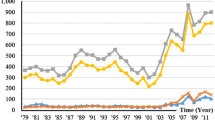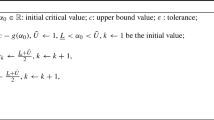Abstract
Electric power options are hardly priced for the non-storable nature of electric energy. A pricing model for European call options on electric power is proposed, which is expected to give option premiums to investors by using optimization, expected utility as well as fuzzy measure theories. Firstly, a formula of the option premium based on maximizing the utility of investment wealth is given, where the utility function represents the investor’s preference for wealth and the Choquet expected integral with the λ-additive fuzzy measure is used to express the difference between investors in the estimation of option value. Then, combined with practical constraints a pricing model for the electric power option is obtained by maximizing the utility of investment wealth with the fuzzy measures. The integration of fuzzy measure and probability measure depicts the uncertainty of the option value, making the produced option premium worthwhile to refer to. Lastly, the impacts of utility functions, fuzzy parameters and practical constraints are tested by examples.

Similar content being viewed by others
Explore related subjects
Discover the latest articles, news and stories from top researchers in related subjects.References
Scholesm BF (1973) The pricing of options corporate liabilities. J Polit Econ 81(3):637–659
Hull JC (2005) Options, futures and other derivatives, 3rd edn. Prentice Hull, New York
Muzzioli S, Torricelli C (2002) Implied trees in illiquid markets: a Choquet pricing approach. Int J Intell Syst 17(6):577–594
Appadoo SS et al (2008) Application of possibility theory to investment decisions. Fuzzy Optim Decis Making 7(1):35–57
Ewald CO, Yang ZJ (2008) Utility based pricing and exercising of real options under geometric mean reversion and risk aversion toward idiosyncratic risk. Math Methods Oper Res 68(1):97–123
Haarbrucker G, Kuhn D (2009) Valuation of electricity swing options by multistage stochastic programming. Automatica 45(4):889–899
Cotter J, Hanly J (2012) Hedging effectiveness under conditions of asymmetry. Eur J Finance 18(2):135–147
Wang X, He Y, Dong L et al (2011) Particle swarm optimization for determining fuzzy measures from data. Inf Sci 181(19):4230–4252
Zhang Z (2011) Some discussions on uncertain measure. Fuzzy Optim Decis Making 10(1):31–43
Yager Ronald R (2011) A measure based approach to the fusion of possibilistic and probabilistic uncertainty. Fuzzy Optim Decis Making 10(2):91–113
Xu XW, Hopp WJ (2009) Price trends in a dynamic pricing model with heterogeneous customers: a martingale perspective. Oper Res 57(5):1298–1302
Shioda R et al (2011) Maximum utility product pricing models and algorithms based on reservation price. Comput Optim Appl 48(2):157–198
Elliott RJ, Siu TK (2011) Utility-based indifference pricing in regime-switching models. Nonlinear Anal-Theory Methods Appl 74(17):6302–6313
Yang JQ, Yang ZJ (2012) Consumption utility-based pricing and timing of the option to invest with partial information. Comput Econ 39(2):195–217
Sakawa M et al (2012) Fuzzy random bilevel linear programming through expectation optimization using possibility and necessity. Int J Mach Learn Cybernet 3(3):183–192
Thavaneswaran A et al (2013) Binary option pricing using fuzzy numbers. Appl Math Lett 26(1):65–72
Kazemi SMR et al (2013) A hybrid intelligent approach for modeling brand choice and constructing a market response simulator. Knowl-Based Syst 40:101–110
Li B, Wang T, Tian W (2013) Risk measures and asset pricing models with new versions of Wang’s transform. Adv Intell Syst Comput 200 AISC:155–167
Gu P et al (2013) Modeling, simulation and design optimization of a hoisting rig active heave compensation system. Int J Mach Learn Cybernet 4(2):85–98
Ramsay CM et al (2013) Pricing high-risk and low-risk insurance contracts with incomplete information and production costs. Insur Math Econ 52(3):606–614
Konstantinos A et al (2013) Papadopoulos. Hybrid (fuzzy-stochastic) modelling in construction operations management. Int J Mach Learn Cybernet 4(4):339–346
Cui Y et al (2013) Probabilistic DEAR models. Int J Mach Learn Cybernet 4(4):373–389
Wu JZ, Zhang QA (2010) 2-order additive fuzzy measure identification method based on diamond pairwise comparison and maximum entropy principle. Fuzzy Optim Decis Making 9(4):435–453
Wang Z (1991) Fuzzy measure theory. Graduate school of the State University of New York, USA
Wang X, Chen A, Feng H (2011) Upper integral network with extreme learning mechanism. Neurocomputing 74(16):2520–2525
Yager RR, Alajlan N (2012) Measure based representation of uncertain information. Fuzzy Optim Decis Making 11(4):363–385
Shakya S et al (2012) Neural network demand models and evolutionary optimisers for dynamic pricing. Knowl-Based Syst 29:44–53
Yechiel A, Shevah Y (2012) Optimization of energy costs for SWRO desalination plants. Desalination Water Treat 46(1–3):304–311
Ksantini R, Boufama B (2012) Combining partially global and local characteristics for improved classification. Int J Mach Learn Cybernet 3(2):119–131
Acknowledgments
This paper is supported by the Fundamental Research Funds for the Central Universities (12MS84), the Co-construction Project of Beijing Municipal commission of Education, the National Natural Science Foundation of China (Grant No. 71171080).
Author information
Authors and Affiliations
Corresponding author
Rights and permissions
About this article
Cite this article
Gu, Y., An, Y., Chen, D. et al. Pricing electric power options by maximizing the utility of investment wealth with fuzzy measures. Int. J. Mach. Learn. & Cyber. 6, 409–415 (2015). https://doi.org/10.1007/s13042-014-0270-0
Received:
Accepted:
Published:
Issue Date:
DOI: https://doi.org/10.1007/s13042-014-0270-0




